
Foibe fanagadrana sy fampijaliana taloha Londres 38, tamin'ny 11 Septambra 2013. Sary avy amin'ilay mpisera Hi Sashi tao amin'ny Flickr, Creative Commons license (CC BY-NC-ND 2.0)
Tao amin'ny bilaogy Memory in Latin America (Fahatsiarovana ao Amerika Latina), namoaka andiàn-dahatsoratra momba ireo “toeram-pahatsiarovana” ao Santiago, renivohitr'i Shily i Lillie Langtry. Ireo toerana ireo dia Fanorenana lehibe na toerana misy ifandraisany tamin'ny fanonganam-panjakana miaramila izay naha-voahongana ny filoha sosialista Salvador Allende tamin'ny 11 septambra 1973, sy ny didy jadona 17 taona notarihan'i Augusto Pinochet. Manamarika ny faha-40 taonan'ny fanonganam-panjakana miaramila ity taona ity.
1. Mozean'ny Fahatsiarovana sy ny Zon'Olombelona
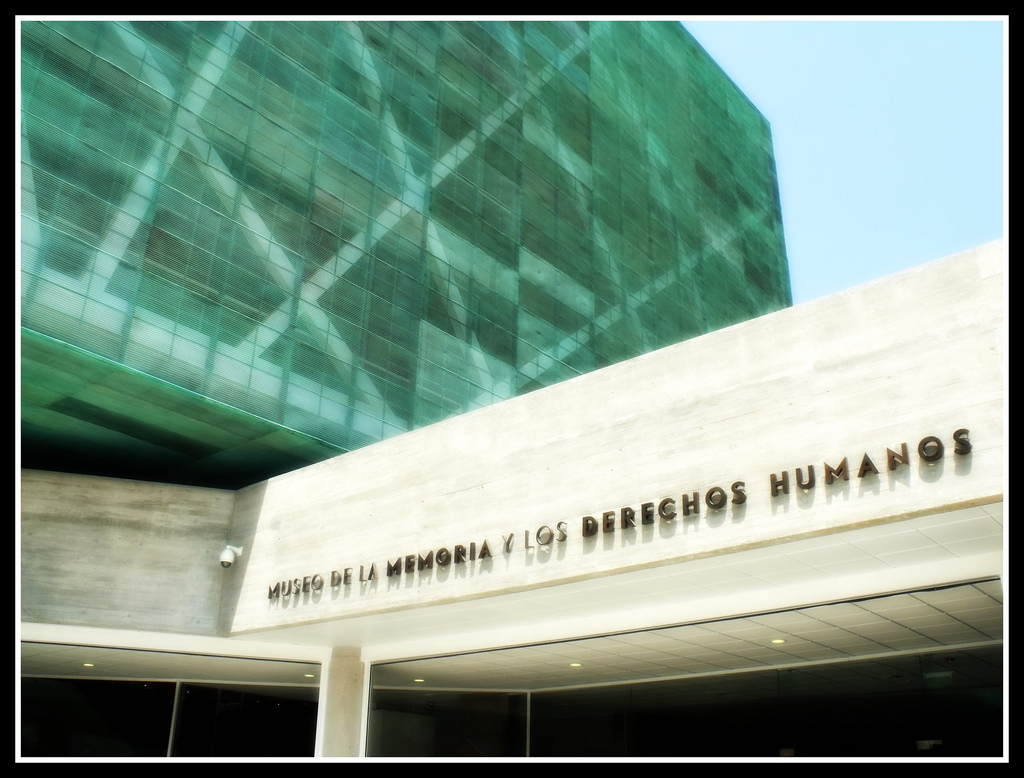
Mozean'ny Fahatsiarovana sy ny Zon'Olombelona. Sary avy amin'i Giovanni A. Pérez tao amin'ny Flickr, Creative Commons license (CC BY-NC 2.0)
Manomboka amin'ny Mozean'ny Fahatsiarovana sy ny Zon'Olombelona [espaniola] ity fitsidihana virtoaly ity, “toerana midadasika sy manintona”, araka ny fanazavan'i Lillie:
Sadly you're not allowed to take photographs inside, which is a real shame, because the most striking feature for me is the huge wall of photographs of the disappeared reaching up across the entire space. There is also a point where you can stand and look out at it and locate individual names and faces.
On the ground floor various terminals show footage of the 1973 coup and its aftermath. As you move upstairs, different areas cover aspects like exiles and international solidarity, media coverage, and torture – including, chillingly, an electric shock device (made by General Electric – not suggesting they intended it to be used for that purpose!). There are also items made by prisoners and photographs of memorial sites throughout Chile.
Indrisy, tsy mahazo maka sary ao anatiny ianao, izay tena henatra tokoa, satria ny tena manintona ahy indrindra dia ny rindrin-tsary goavambe misy ny sarin'ireo nanjavona mahahenika ny tahala iray manontolo. Misy ihany koa toerana izay hahafahanao mitsangana sy mijery izany ary mahita ny anarana sy ny tavan'ireo olona.
Ao ambany rihana no ahitana kiefitrefitra mampiseho lahatsary tamin'ny fanonganam-panjakana tamin'ny taona 1973 sy ny vokatra naterany. Ary raha miakatra any amin'ny ambony rihana ianao, dia maro ny faritra mampiseho endri-javatra samihafa tahaka ny fanaovana sesintany sy ny firaisankina iraisampirenena, fitantarana amin'ny fampahalalam-baovao, ary ny fampijaliana – ahitana, zava-mampangovitra, fitaovana fandoroana amin'ny herinaratra (namboarin'ny General Electric – izay tsy nilaza fa natao ho ampiasaina amin'izany ny fitaovana!). Ahitana zavatra namboarin'ireo gadra sy ny sarin'ireo toeram-pahatsiarovana manerana an'i Shily ihany koa ao.
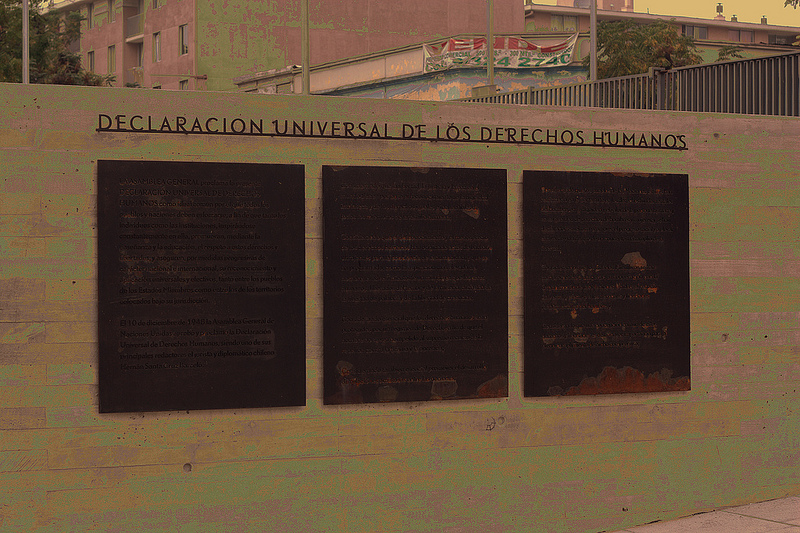
Fanambarana manerantany momba ny Zon'olombelona tao amin'ny Mozean'ny Fahatsiarovana sy ny Zon'Olombelona tao Shily. Sary avy amin'i Jen Dyer tao amin'ny Flickr, Creative Commons license (CC BY-ND 2.0)
Nanamarika ihany koa i Lillie fa “miharihary ny tsy mahatoerana ahafahanao mijoro maha-tsy miandany anao ao na ampifandanjanao ny mpanohana sy ny mpanohitra an'i Pinochet amin'ny fomba mitovy”, ary nanantsonga ny voasoratra amin'ny taratasy fampafantarana ny mozea ihany koa izy:
“The task of building a memory must be guided by a moral compass; we must build a reading of the collective trauma that goes above and beyond what is evident, a history of victims and criminals, guilty and innocent. The goal in the museum's construction of memory is to become a space that assists the culture of human rights and democratic values in becoming the share ethical basis of our present and future coexistence. Only in this way can we empower our claim of NEVER AGAIN.”
Tokony hotarihan'ny fananana maoraly ny asam-pananganana toeram-pahatsiarovana; tsy maintsy manangana ny famakiana ny ratram-panahy iombonana izay mihoatra noho izay miharihary, tantaran'ireo lasibatra sy ireo mpamono olona, ireo meloka sy ireo tsy manan-tsiny, isika. Ny tanjona amin'ny fananganana ny mozean'ny fahatsiarovana dia ny hanaovana azy ireny ho lasa tahala manohana ny kolontsain'ny zon'olombelona sy ny hasina demokratika ka hahatonga azy ireny ho fototra mamaritra ny ankehitriny sy ny fiaraha-miaina rahampitso. Amin'izay fomba tokana izay ihany no hahafahantsika manamafy ny hoe TSY MILA IZANY INTSONY.”
Azonao jerena ao amin'ny Flickr ireo sary maro hafa momba ny mozea (anisan'izany ireo sasany avy ao anatiny).
2. Londres 38
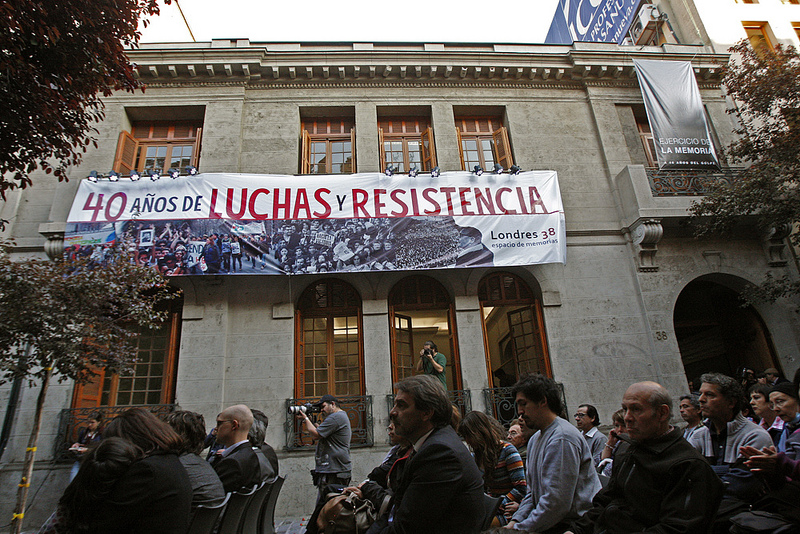
“40 Taona Nitolomana sy Nanoherana”: Londres 38, foibe famonjàna sy fampijaliana taloha tao Santiago, Shily. Sary avy amin'ny ben'ny tanànan'i Santiago tao amin'ny Flickr. Creative Commons license (CC BY-NC-ND 2.0)
Tamin'ny lahatsoratra hafa, nanoratra momba ny foibe famonjàna sy fampijaliana taloha antsoina hoe Londres 38 i Lillie:
It was used by the DINA (secret police) as a torture and holding centre for regime opponents, at least 98 of whom died there or afterwards [es]. In front of the building, victims’ names are embedded among the cobble stones (similar to the Stolperstein in Germany).
Nampiasain'ny DINA (polisin'ny fitsikilovana) ho foibem-pampijaliana sy fanagadrana ireo mpanohitra ny fitondrana, ka farafahakeliiny 98 tamin'izy ireo no namoy ny ainy tao na taoriana kely [es]. Eo anoloan'ny tranobe, miraikitra eo amin'ny rindrim-bato (mitovy amin'ny Stolpersteine ao Alemaina) ny anaran'ireo niharany.
Hoy izy nanampy:
I was initially a little surprised at the condition of the walls, but of course it makes far more sense to see it like this than artificially spruced up. You certainly get more of a sense for the suffering that took place there; although it's also really amazing to think how central the location is. Ilovechile.cl writes that the building was known for the loud classical music coming from it – pretty chilling when you realise what that music was covering up.
Somary gaga aho tamin'ny voalohany, nahita ny toetry ny rindrina, saingy misy dikany kokoa izy tahaka izao toy izay feno fanaamboamboarana. Hahatsapa kokoa ny fangirifiriana nisy teo amin'io toerana io ianao; na dia mahatalanjona tokoa aza ny mihevitra hoe tena mahazo ny afovoan-tanàna tokoa ilay toerana. Nanoratra i Ilovechile.cl fa fantatra tamin'ny mozika klasika mitabataba mafy avy ao anatiny ilay tranobe – mampatahotra ihany rehefa fantatra hoe inona no rakofan'izany mozika izany .

Londres 38 tamin'ny 11 Septambra 2013. Sary avy amin'i César Castillo tao amin'ny Flickr, Creative Commons license (CC BY-NC-ND 2.0)
3. La Moneda
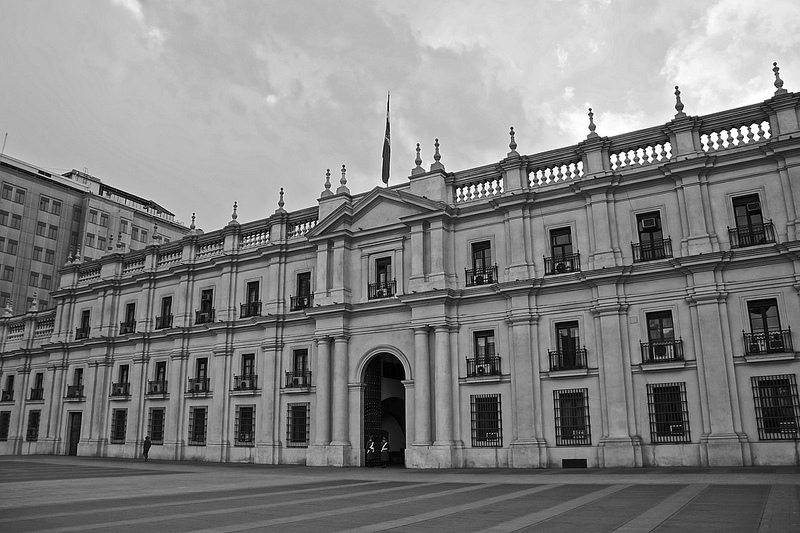
La Moneda, lapam-panjakana Shiliana. Sary avy amin'ilay mpisera Alobos Life tao amin'ny Flickr, Creative Commons license (CC BY-NC-ND 2.0)
Namoaka lahatsoratra momba ny lapam-panjakana shiliana, izay voadaroka baomba nandritra ny fanonganam-panjakana tamin'ny 11 septambra 1973 ihany koa i Lillie.
Francisco Vergara nanoratra momba ny daroka baomba tao amin'ny Democracities :
This building, considered a symbol of national independence and republican tradition, a built expression of the social progression, was completely burned and destroyed by the own military forces that swore loyalty to the nation and its constitution. Imagine two F-16s bombing the White House, or two Typhoons bombing Buckingham Palace… A scene really hard to believe. This attack was a sign of the end of a republican and democratic era.
ty tranobe ity, izay heverina ho sariohatry ny fahaleovantenam-pirenena sy tarazo repoblikana ity, tsangambaton'ny fandrosoana ara-tsosialy dia nodorana sy nopotehin'ny hery miaramilany izay nanao fianianana ho tokin'ny firenena sy ny lalàmpanorenany I. Saintsaino anie izany hoe F-16 roa midaroka baomba ny Trano Fotsy, na “Rivodoza” (Typhoons) roa midaroka ny Lapa Buckingham… Tranga sarotra inoana indrindra. Izany fanafihana izany no marika fiafaran'ny vanim-potoana repoblikana sy demaokratika .

Efa-polo taona taorian'ny fanonganam-panjakana. La Moneda. Sary avy amin'i Hi Sashi tao amin'ny Flickr, Creative Commons license (CC BY-NC-ND 2.0)
4. Tsangambato fahatsiarovana hoan'ireo nanjavona

Tsangambato fahatsiarovana reo izay nogadraina, ireo izay nanjavona ary ireo izay notapahan-doha noho ny antony ara-politika. Sary avy amin'ilay mpisera Nuevasantiago tao amin'ny Flickr, Creative Commons license (CC BY-NC-SA 2.0)
Tamin'ny lahatsoratra navoakany farany teo momba ireo toeram-pahatsiarovana ao Santiago, nilaza momba ny tsangambato fahatsiarovana ireo Nanjavona i Lillie: “rindrina goavambe vita amin'ny vato ahitana ny lisitr'ireo lasibatra no voasokitra ao anatin'izany”.
Nanazava izy fa ao anatin'ny tokotanim-pasana no misy ny tsangambato fahatsiarovana :
I always really like seeing a memorial used, actually part of the fabric of life. In this case, at the bottom of the memorial are many notes, photos, little plaques, flowers, and so on. It's a sombre site but then, it is in a graveyard. The important thing is these victims did not previously have anywhere where their families could go to mourn them and to mark their lives, and now they do, and they are acknowledged in the chief cemetery of the capital city as being part of the country's history.
Nankafiziko foana ny mijery ny fomba nampiasàna ireny tsangambato fahatsiarovana ireny, izay ao anatin'ny vanim-potoana iainana . Amin'ity tranga ity, eo amin'ny fanambanin'ny tsangambato dia ahitana naoty, sary, takelaka madinika , voninkazo marobe sy sisa hafa . Toerana matromatroka izany, satria ao anatin'ny tokotanim-pasana. Ny zava-dehibe dia tsy mba nanana toerana isaonana ny fianakavian'ny lasibatra tamin'ny voalohany sy hanamarihany ny fiainany, ary ankehitriny manana izany ry zareo, ary mankasitraka ny lehiben'ny tokotanim-pasan'ny renivohitra lasa mametraka azy ho ao anatin'ny tantaran'ny firenena
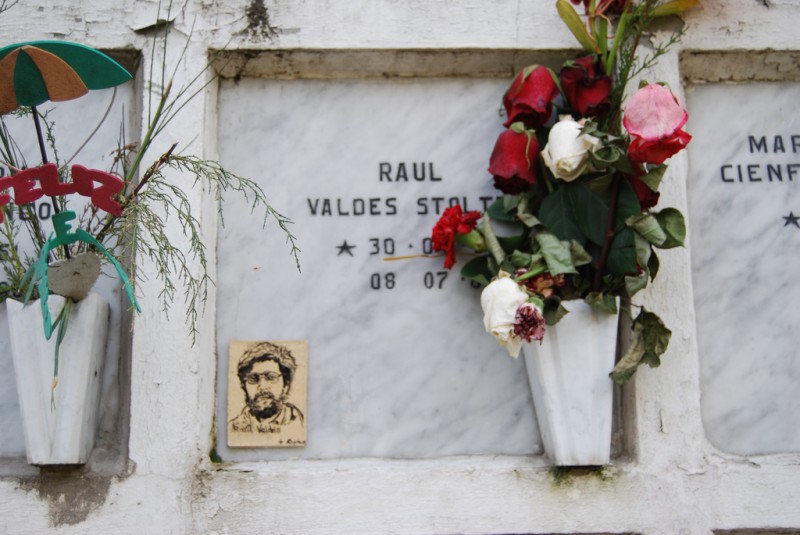
Raúl Valdés Stoltze. Tsangambato fahatsiarovana ireo nanjavona. Sary avy amin'i Paul Lowry tao amin'ny Flickr, Creative Commons license (CC BY 2.0)
Tsidiho ny bilaogin'i Lillie raha te-hamaky lahatsoratra bebe kokoa momba ny tsiaro sy ny zon'olombelona ao Amerika Latina. Azonao atao ihany koa ny manaraka azy ao amin'ny Twitter:@Lillie_Langtry.
5. Ny kianjam-pirenena
Farany, tianay ny manampy toeram-pahatsiarovana iray fanampiny ao Santiago: ny Kianjam-pirenena (Estadio Nacional amin'ny teny espaniola), nampiasaina ho foibem-pigadrana sy fampijaliana.
Araka ny fanazavan'i Pascale Bonnefoy tao amin'ny Global Post, “Ny tombatombana amin'ny fitambaran'ny isan'ireo gadra dia 7 000 hatramin'ny 20 000, ka 1 000 eo ho eo ny vehivavy. […] Ny toerana nanaovana fampijaliana dia teo amin'ny toeram-pihazakazahana am-bisikileta, tao amin'ny biraom-panjakana, teny amin'ny lalantsara ary teny amin'ny kianja. Tsy misy tarehimarika raikitra mikasika izay isan'ny olona novonoina na nanjavona tao amin'ity kianjabe ity.”








